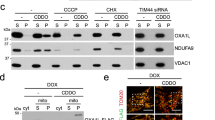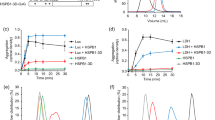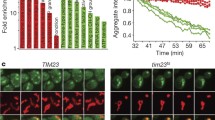Abstract
The mitochondrial 70-kDa heat shock protein (mtHsp70), also known in humans as mortalin, is a central component of the mitochondrial protein import motor and plays a key role in the folding of matrix-localized mitochondrial proteins. MtHsp70 is assisted by a member of the 40-kDa heat shock protein co-chaperone family named Tid1 and a nucleotide exchange factor. Whereas, yeast mtHsp70 has been extensively studied in the context of protein import in the mitochondria, and the bacterial 70-kDa heat shock protein was recently shown to act as an ATP-fuelled unfolding enzyme capable of detoxifying stably misfolded polypeptides into harmless natively refolded proteins, little is known about the molecular functions of the human mortalin in protein homeostasis. Here, we developed novel and efficient purification protocols for mortalin and the two spliced versions of Tid1, Tid1-S, and Tid1-L and showed that mortalin can mediate the in vitro ATP-dependent reactivation of stable-preformed heat-denatured model aggregates, with the assistance of Mge1 and either Tid1-L or Tid1-S co-chaperones or yeast Mdj1. Thus, in addition of being a central component of the protein import machinery, human mortalin together with Tid1, may serve as a protein disaggregating machine which, for lack of Hsp100/ClpB disaggregating co-chaperones, may carry alone the scavenging of toxic protein aggregates in stressed, diseased, or aging human mitochondria.



Similar content being viewed by others
References
Aldridge JE, Horibe T, Hoogenraad NJ (2007) Discovery of genes activated by the mitochondrial unfolded protein response (mtUPR) and cognate promoter elements. PLoS One 2(9):e874. doi:10.1371/journal.pone.0000874
Baumann F, Milisav I, Neupert W, Herrmann JM (2000) Ecm10, a novel hsp70 homolog in the mitochondrial matrix of the yeast Saccharomyces cerevisiae. FEBS Lett 487(2):307–312
Bhattacharyya T, Karnezis AN, Murphy SP, Hoang T, Freeman BC, Phillips B, Morimoto RI (1995) Cloning and subcellular localization of human mitochondrial hsp70. J Biol Chem 270(4):1705–1710
Blamowska M, Sichting M, Mapa K, Mokranjac D, Neupert W, Hell K (2010) ATPase domain and interdomain linker play a key role in aggregation of mitochondrial Hsp70 chaperone Ssc1. J Biol Chem 285(7):4423–4431. doi:10.1074/jbc.M109.061697
Broadley SA, Hartl FU (2009) The role of molecular chaperones in human misfolding diseases. FEBS Lett 583(16):2647–2653. doi:10.1016/j.febslet.2009.04.029
Burbulla LF, Schelling C, Kato H, Rapaport D, Woitalla D, Schiesling C, Schulte C, Sharma M, Illig T, Bauer P, Jung S, Nordheim A, Schols L, Riess O, Kruger R (2010) Dissecting the role of the mitochondrial chaperone mortalin in Parkinson’s disease: functional impact of disease-related variants on mitochondrial homeostasis. Hum Mol Genet. doi:10.1093/hmg/ddq370
D’Silva P, Liu Q, Walter W, Craig EA (2004) Regulated interactions of mtHsp70 with Tim44 at the translocon in the mitochondrial inner membrane. Nat Struct Mol Biol 11(11):1084–1091. doi:10.1038/nsmb846
Daugaard M, Rohde M, Jaattela M (2007) The heat shock protein 70 family: Highly homologous proteins with overlapping and distinct functions. FEBS Lett 581(19):3702–3710. doi:10.1016/j.febslet.2007.05.039
De Castro IP, Martins LM, Tufi R (2010) Mitochondrial quality control and neurological disease: an emerging connection. Expert Rev Mol Med 12:e12. doi:10.1017/S1462399410001456
De Los Rios P, Ben-Zvi A, Slutsky O, Azem A, Goloubinoff P (2006) Hsp70 chaperones accelerate protein translocation and the unfolding of stable protein aggregates by entropic pulling. Proc Natl Acad Sci USA 103(16):6166–6171. doi:10.1073/pnas.0510496103
De Mena L, Coto E, Sanchez-Ferrero E, Ribacoba R, Guisasola LM, Salvador C, Blazquez M, Alvarez V (2009) Mutational screening of the mortalin gene (HSPA9) in Parkinson’s disease. J Neural Transm 116(10):1289–1293. doi:10.1007/s00702-009-0273-2
Deloche O, Liberek K, Zylicz M, Georgopoulos C (1997) Purification and biochemical properties of Saccharomyces cerevisiae Mdj1p, the mitochondrial DnaJ homologue. J Biol Chem 272(45):28539–28544
Deocaris CC, Widodo N, Ishii T, Kaul SC, Wadhwa R (2007) Functional significance of minor structural and expression changes in stress chaperone mortalin. Ann N Y Acad Sci 1119:165–175. doi:10.1196/annals.1404.007
Deocaris CC, Kaul SC, Wadhwa R (2008) From proliferative to neurological role of an hsp70 stress chaperone, mortalin. Biogerontology 9(6):391–403. doi:10.1007/s10522-008-9174-2
Diamant S, Ben-Zvi AP, Bukau B, Goloubinoff P (2000) Size-dependent disaggregation of stable protein aggregates by the DnaK chaperone machinery. J Biol Chem 275(28):21107–21113. doi:10.1074/jbc.M001293200
Dutkiewicz R, Schilke B, Knieszner H, Walter W, Craig EA, Marszalek J (2003) Ssq1, a mitochondrial Hsp70 involved in iron-sulfur (Fe/S) center biogenesis. Similarities to and differences from its bacterial counterpart. J Biol Chem 278(32):29719–29727. doi:10.1074/jbc.M303527200
Genevaux P, Georgopoulos C, Kelley WL (2007) The Hsp70 chaperone machines of Escherichia coli: a paradigm for the repartition of chaperone functions. Mol Microbiol 66(4):840–857. doi:10.1111/j.1365-2958.2007.05961.x
Glover JR, Lindquist S (1998) Hsp104, Hsp70, and Hsp40: a novel chaperone system that rescues previously aggregated proteins. Cell 94(1):73–82
Goloubinoff P, De Los Rios P (2007) The mechanism of Hsp70 chaperones: (entropic) pulling the models together. Trends Biochem Sci 32(8):372–380. doi:10.1016/j.tibs.2007.06.008
Goloubinoff P, Mogk A, Zvi AP, Tomoyasu T, Bukau B (1999) Sequential mechanism of solubilization and refolding of stable protein aggregates by a bichaperone network. Proc Natl Acad Sci USA 96(24):13732–13737
Goswami AV, Chittoor B, D’Silva P (2010) Understanding the functional interplay between mammalian mitochondrial Hsp70 chaperone machine components. J Biol Chem 285(25):19472–19482. doi:10.1074/jbc.M110.105957
Hansen JE, Gafni A (1993) Thermal switching between enhanced and arrested reactivation of bacterial glucose-6-phosphate dehydrogenase assisted by GroEL in the absence of ATP. J Biol Chem 268(29):21632–21636
Hinault MP, Farina-Henriquez-Cuendet A, Mattoo RU, Mensi M, Dietler G, Lashuel HA, Goloubinoff P (2010) Stable {alpha}-synuclein oligomers strongly inhibit chaperone activity of the HSP70 system by weak interactions with J-domain co-chaperones. J Biol Chem. doi:10.1074/jbc.M110.127753
Horst M, Oppliger W, Rospert S, Schonfeld HJ, Schatz G, Azem A (1997) Sequential action of two hsp70 complexes during protein import into mitochondria. EMBO J 16(8):1842–1849. doi:10.1093/emboj/16.8.1842
Iosefson O, Azem A (2010) Reconstitution of the mitochondrial Hsp70 (mortalin)-p53 interaction using purified proteins—identification of additional interacting regions. FEBS Lett. doi:10.1016/j.febslet.2010.02.019
Kaul SC, Deocaris CC, Wadhwa R (2007) Three faces of mortalin: a housekeeper, guardian and killer. Exp Gerontol 42(4):263–274. doi:10.1016/j.exger.2006.10.020
Koren J 3rd, Jinwal UK, Lee DC, Jones JR, Shults CL, Johnson AG, Anderson LJ, Dickey CA (2009) Chaperone signalling complexes in Alzheimer’s disease. J Cell Mol Med 13(4):619–630
Laufen T, Mayer MP, Beisel C, Klostermeier D, Mogk A, Reinstein J, Bukau B (1999) Mechanism of regulation of hsp70 chaperones by DnaJ cochaperones. Proc Natl Acad Sci USA 96(10):5452–5457
Liu Q, Krzewska J, Liberek K, Craig EA (2001) Mitochondrial Hsp70 Ssc1: role in protein folding. J Biol Chem 276(9):6112–6118. doi:10.1074/jbc.M009519200
Lu B, Garrido N, Spelbrink JN, Suzuki CK (2006) Tid1 isoforms are mitochondrial DnaJ-like chaperones with unique carboxyl termini that determine cytosolic fate. J Biol Chem 281(19):13150–13158. doi:10.1074/jbc.M509179200
Mapa K, Sikor M, Kudryavtsev V, Waegemann K, Kalinin S, Seidel CA, Neupert W, Lamb DC, Mokranjac D (2010) The conformational dynamics of the mitochondrial Hsp70 chaperone. Mol Cell 38(1):89–100. doi:10.1016/j.molcel.2010.03.010
Mitra A, Shevde LA, Samant RS (2009) Multi-faceted role of HSP40 in cancer. Clin Exp Metastasis 26(6):559–567. doi:10.1007/s10585-009-9255-x
Mizzen LA, Chang C, Garrels JI, Welch WJ (1989) Identification, characterization, and purification of two mammalian stress proteins present in mitochondria, grp 75, a member of the hsp 70 family and hsp 58, a homolog of the bacterial groEL protein. J Biol Chem 264(34):20664–20675
Mogk A, Tomoyasu T, Goloubinoff P, Rudiger S, Roder D, Langen H, Bukau B (1999) Identification of thermolabile Escherichia coli proteins: prevention and reversion of aggregation by DnaK and ClpB. EMBO J 18(24):6934–6949. doi:10.1093/emboj/18.24.6934
Neupert W, Herrmann JM (2007) Translocation of proteins into mitochondria. Annu Rev Biochem 76:723–749. doi:10.1146/annurev.biochem.76.052705.163409
Pedersen CB, Bross P, Winter VS, Corydon TJ, Bolund L, Bartlett K, Vockley J, Gregersen N (2003) Misfolding, degradation, and aggregation of variant proteins. The molecular pathogenesis of short chain acyl-CoA dehydrogenase (SCAD) deficiency. J Biol Chem 278(48):47449–47458. doi:10.1074/jbc.M309514200
Rowley N, Prip-Buus C, Westermann B, Brown C, Schwarz E, Barrell B, Neupert W (1994) Mdj1p, a novel chaperone of the DnaJ family, is involved in mitochondrial biogenesis and protein folding. Cell 77(2):249–259
Schapira AH (1998) Mitochondrial dysfunction in neurodegenerative disorders. Biochim Biophys Acta 1366(1–2):225–233
Sharma SK, Christen P, Goloubinoff P (2009) Disaggregating chaperones: an unfolding story. Curr Protein Pept Sci 10(5):432–446
Sharma SK, De Los Rios P, Christen P, Lustig A, Goloubinoff P (2010) The kinetic parameters and energy cost of the Hsp70 chaperone as a polypeptide unfoldase. Nat Chem Biol. doi:10.1038/nchembio.455
Shi M, Jin J, Wang Y, Beyer RP, Kitsou E, Albin RL, Gearing M, Pan C, Zhang J (2008) Mortalin: a protein associated with progression of Parkinson disease? J Neuropathol Exp Neurol 67(2):117–124. doi:10.1097/nen.0b013e318163354a
Sichting M, Mokranjac D, Azem A, Neupert W, Hell K (2005) Maintenance of structure and function of mitochondrial Hsp70 chaperones requires the chaperone Hep1. EMBO J 24(5):1046–1056. doi:10.1038/sj.emboj.7600580
Swain JF, Dinler G, Sivendran R, Montgomery DL, Stotz M, Gierasch LM (2007) Hsp70 chaperone ligands control domain association via an allosteric mechanism mediated by the interdomain linker. Mol Cell 26(1):27–39. doi:10.1016/j.molcel.2007.02.020
Syken J, De-Medina T, Munger K (1999) TID1, a human homolog of the Drosophila tumor suppressor l(2)tid, encodes two mitochondrial modulators of apoptosis with opposing functions. Proc Natl Acad Sci USA 96(15):8499–8504
Szabo A, Langer T, Schroder H, Flanagan J, Bukau B, Hartl FU (1994) The ATP hydrolysis-dependent reaction cycle of the Escherichia coli Hsp70 system DnaK, DnaJ, and GrpE. Proc Natl Acad Sci USA 91(22):10345–10349
Vijayvergiya C, Beal MF, Buck J, Manfredi G (2005) Mutant superoxide dismutase 1 forms aggregates in the brain mitochondrial matrix of amyotrophic lateral sclerosis mice. J Neurosci 25(10):2463–2470. doi:10.1523/JNEUROSCI.4385-04.2005
von Janowsky B, Major T, Knapp K, Voos W (2006) The disaggregation activity of the mitochondrial ClpB homolog Hsp78 maintains Hsp70 function during heat stress. J Mol Biol 357(3):793–807. doi:10.1016/j.jmb.2006.01.008
Wadhwa R, Kaul SC, Ikawa Y, Sugimoto Y (1993) Identification of a novel member of mouse hsp70 family. Its association with cellular mortal phenotype. J Biol Chem 268(9):6615–6621
Weibezahn J, Schlieker C, Tessarz P, Mogk A, Bukau B (2005) Novel insights into the mechanism of chaperone-assisted protein disaggregation. Biol Chem 386(8):739–744. doi:10.1515/BC.2005.086
Xie W, Wan OW, Chung KK (2010) New insights into the role of mitochondrial dysfunction and protein aggregation in Parkinson’s disease. Biochim Biophys Acta 1802(11):935–941. doi:10.1016/j.bbadis.2010.07.014
Zhai P, Stanworth C, Liu S, Silberg JJ (2008) The human escort protein Hep binds to the ATPase domain of mitochondrial hsp70 and regulates ATP hydrolysis. J Biol Chem 283(38):26098–26106. doi:10.1074/jbc.M803475200
Zhao Q, Wang J, Levichkin IV, Stasinopoulos S, Ryan MT, Hoogenraad NJ (2002) A mitochondrial specific stress response in mammalian cells. EMBO J 21(17):4411–4419
Acknowledgments
We thank Zvi Fishelson and Moran Saar for plasmids of mortalin’s domains. A.A. is supported by the German-Israeli Foundation for Scientific Research and Development (GIF-1012/08) and Israel Science Foundation (452/09). O.I. was partially supported by a grant from Philip Morris International.
Author information
Authors and Affiliations
Corresponding author
Additional information
Ohad Iosefson and Shelly Sharon contributed equally to this study.
Electronic supplementary materials
Below is the link to the electronic supplementary material.
Supplementary Fig. 1
Sequence alignment of human mortalin with yeast mtHsp70s (Ssc1, Ssq1, and Ecm10) and E. coli DnaK. (DOC 842 kb)
Supplementary Fig. 2
Sequence alignment of human Tid1-L and Tid1-S, yeast mtHsp40 (Mdj1). and E coli DnaJ. (DOC 530 kb)
Supplementary Fig. 3
Purification steps of mortalin. (DOC 1,255 kb)
Supplementary Fig. 4
Purification steps of Tid1-L. (DOC 1,388 kb)
Supplementary Fig. 5
The ATPase activity of mortalin is not stimulated by Tid1-L H121Q, under single-turnover conditions. (DOC 52 kb)
Supplementary Fig. 6
Time-dependent reactivation of stable G6PDH aggregates by mortalin and mortalin-V482F. (DOC 56 kb)
Supplementary Table 1
Sequence of primers (DOC 36 kb)
Rights and permissions
About this article
Cite this article
Iosefson, O., Sharon, S., Goloubinoff, P. et al. Reactivation of protein aggregates by mortalin and Tid1—the human mitochondrial Hsp70 chaperone system. Cell Stress and Chaperones 17, 57–66 (2012). https://doi.org/10.1007/s12192-011-0285-3
Received:
Revised:
Accepted:
Published:
Issue Date:
DOI: https://doi.org/10.1007/s12192-011-0285-3




